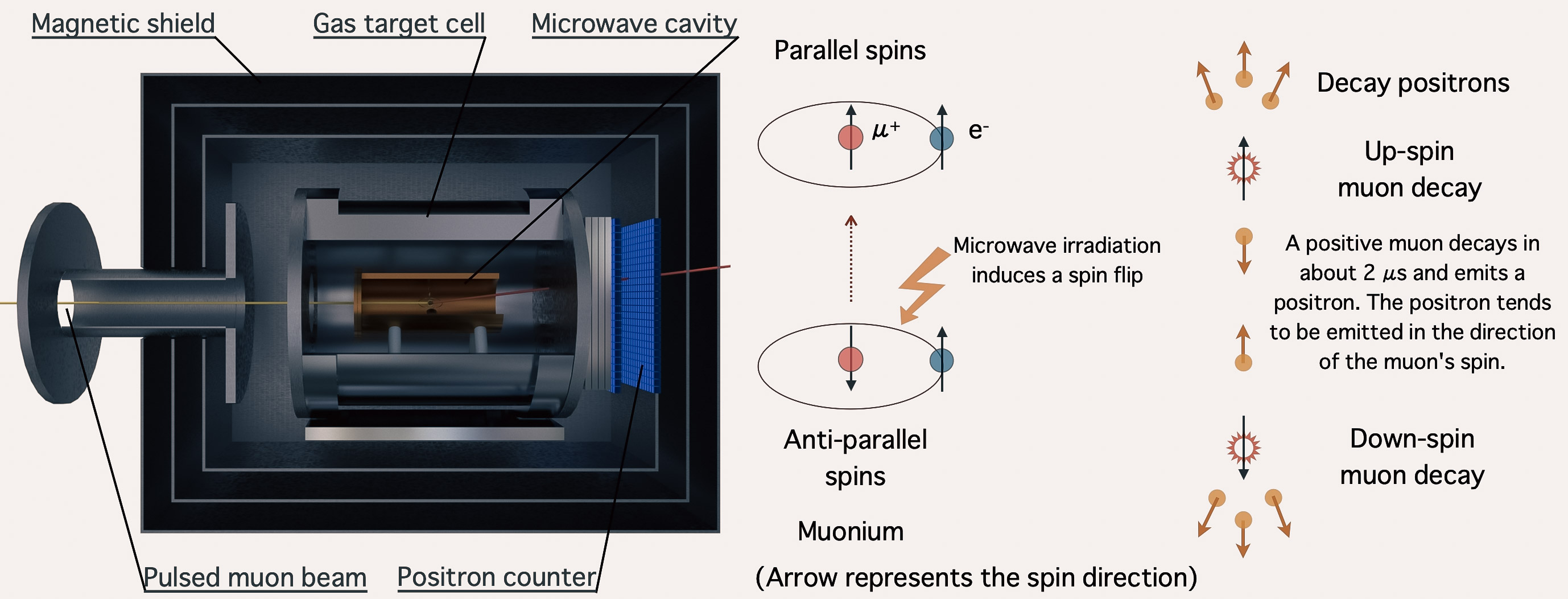MuSEUM Zero-Field
Muonium HFS spectroscpy under a near-zero magnetic field
Introduction: The Ideal Atom
In the quest to understand the fundamental laws of nature, physicists often seek the simplest possible systems to study. Muonium is one such system—an exotic atom consisting of a positive muon and an electron. Unlike hydrogen, which has a complex proton at its core, muonium is composed of two structureless leptons. This makes it a near-ideal laboratory for testing Quantum Electrodynamics (QED)—the theory of how light and matter interact—and for searching for new physics beyond the Standard Model, free from the uncertainties of nuclear structure. The MuSEUM (Muonium Spectroscopy Experiment Using Microwave) collaboration was formed to perform a new, ultra-precise measurement of a key property of this atom: its ground-state hyperfine structure (HFS), which is the tiny energy split between its two lowest-lying spin states.
The Experimental Approach at J-PARC
The experiment is conducted at the Materials and Life Science Experimental Facility (MLF) at J-PARC in Tokai, Japan, which provides the world’s most intense pulsed muon beam. This high-intensity pulsed beam is a key advantage over previous experiments at facilities like LAMPF, which used continuous beams that had to be electronically “chopped,” losing a significant fraction of the valuable muons and limiting the statistical precision.
In the zero-field measurement, spin-polarized positive muons are directed into a chamber filled with krypton gas. The muons slow down and capture an electron from the gas, forming muonium atoms. To perform the measurement in a “zero-field” environment, the entire apparatus is placed inside a sophisticated three-layer magnetic shield that cancels out the Earth’s magnetic field and other stray fields, reducing the residual field to less than 60 nT. A precisely tuned microwave field is then applied within a copper cavity to induce the transition between the muonium HFS states. This transition flips the muon’s spin, and the change is detected by measuring the direction of positrons emitted when the muons decay, using a high-rate, segmented positron counter.

Demonstrating the Principle: Conventional Spectroscopy
The initial phase of the zero-field experiment successfully demonstrated that precision spectroscopy was possible with the intense pulsed beam from J-PARC, a significant technical challenge due to the high instantaneous event rates that can overwhelm detectors. In 2017, the collaboration used a conventional spectroscopy method: the microwave frequency was carefully swept across the expected resonance, and the resulting signal from the positron detector was integrated over time to draw a resonance curve. The center of this curve determines the HFS frequency. This measurement yielded a value of vHFS =4,463,302(4) GHz, a precision of 0.9 parts per million (ppm), which was consistent with previous results and proved the viability of the experimental setup.

A New Technique: Rabi-Oscillation Spectroscopy
Building on this success, the collaboration developed and established a powerful new analysis technique named Rabi-oscillation spectroscopy. This method represents a fundamental shift away from the traditional frequency-sweep approach. Instead of integrating the signal over time to form a resonance curve, this technique analyzes the time evolution of the signal directly. When muonium interacts with the microwave field, its spin “wobbles” back and forth in a process called Rabi oscillation. The exact shape of this oscillation—how fast it oscillates and the height of its peaks—is directly related to how far the applied microwave frequency is from the true resonance frequency.
By fitting the time-dependent signal with a theoretical model that accounts for the oscillation, the HFS frequency can be determined without ever sweeping the frequency. This innovative method has several key advantages:
Enhanced Precision: Simulations and analysis show it can be up to twice as precise as the conventional method by concentrating all measurement time at an optimized frequency, slightly off-resonance.
Robustness and Efficiency: The method can simultaneously determine both the HFS frequency and the effective microwave power from the same data. This makes the analysis remarkably robust against experimental instabilities, such as microwave power drifts, which were a source of systematic uncertainty in previous methods. It allows data taken under different conditions to be analyzed together, making incredibly efficient use of the limited accelerator beam time.
Achieving World-Record Precision at Zero-Field
Applying this novel Rabi-oscillation spectroscopy to data taken in 2018, the MuSEUM collaboration determined the muonium HFS to be νHFS=4,463,301.61±0.71 kHz. This result stands as the most precise measurement of this value ever achieved under zero-field conditions. It successfully demonstrates the power and superiority of the new technique for this class of experiment.
Conclusion
The zero-field phase of the MuSEUM experiment has been a resounding success. It has not only validated the use of the world’s highest-intensity pulsed muon beam for precision spectroscopy but has also pioneered a new and more powerful analysis paradigm with Rabi-oscillation spectroscopy. These achievements provide a crucial foundation and confidence for the ultimate goal of the MuSEUM project: a subsequent measurement in a high magnetic field, which aims to improve the precision of the muonium HFS by another order of magnitude and provide one of the most stringent tests of bound-state QED and the Standard Model to date.